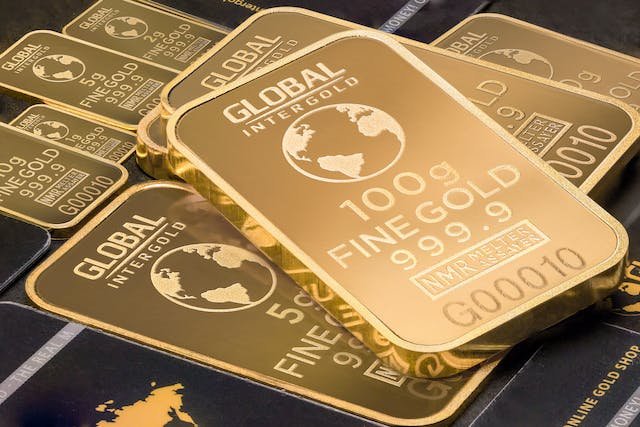Last Updated on July 14, 2024 by Asfa Rasheed
Table of Contents
Physical Metals (Bullion, Coins)
Physical ownership of gold and precious metals is the most traditional form of investment. Investors can purchase bullion bars or coins, with purity and weight being key factors determining value. This tangible form of investment is often preferred for its direct ownership, historical value, and aesthetic appeal. However, it requires secure storage and insurance, adding to the investment’s overall cost.
Gold and Precious Metals Stocks (Mining Companies, ETFs)
Investing in stocks of mining companies is a way to gain exposure to precious metals without owning the physical asset. These stocks tend to be volatile, as they’re not only influenced by metal prices but also by company performance and mining operations. Exchange-Traded Funds (ETFs) that focus on gold and precious metals stocks offer a more diversified investment, mitigating some of the risks associated with individual stocks.
Mutual Funds and ETFs Specializing in Precious Metals
Mutual funds and ETFs offer a diversified portfolio of precious metals investments, including mining stocks, physical metal holdings, and other related assets. These funds are managed by professionals, providing an accessible entry point for investors looking to diversify their portfolios with precious metals without the need for extensive market knowledge.
Futures and Options for More Advanced Investors
Futures and options contracts allow investors to speculate on the future price of precious metals without the need to physically own them. These financial instruments can offer high returns but come with increased risk and complexity, making them more suitable for experienced investors.
Benefits of Investing in Gold and Precious Metals
Diversification of Investment Portfolio
Gold and precious metals can diversify an investment portfolio, reducing its overall risk. Their value often moves independently of stocks and bonds, providing a safeguard against market downturns.
Hedge Against Inflation and Economic Downturns
Precious metals have historically maintained their value in the face of inflation and currency devaluation. During economic instability, investors turn to gold and precious metals as a “safe haven” asset.
Potential for Long-term Growth
Over the long term, gold and precious metals have shown the potential for significant price appreciation, driven by demand in jewelry, technology, and as investment assets.
Risks and Considerations
Market Volatility and Liquidity Issues
The prices of gold and precious metals can be highly volatile, influenced by global economic factors, currency fluctuations, and changes in demand. Additionally, selling physical metals may not be as liquid as selling stocks or ETFs, potentially complicating quick exits from the investment.
Storage and Insurance for Physical Metals
Owning physical gold and precious metals requires secure storage solutions, whether in a home safe or a bank deposit box, along with insurance against theft or loss, adding to the cost of the investment.
Evaluation of Mining Companies and ETFs
Investing in mining companies and ETFs requires due diligence to assess company health, management effectiveness, and the fund’s investment strategy, as these factors can significantly impact investment returns.
Strategies for Successful Investing
Allocation and Diversification Within the Precious Metals Sector
A balanced approach to investing in gold and precious metals involves diversifying across different types of investments (physical, stocks, ETFs) and metals (gold, silver, platinum, palladium) to mitigate risks.
Long-term vs. Short-term Investment Strategies
While some investors prefer holding precious metals for long-term wealth preservation, others may engage in short-term trading to capitalize on market fluctuations. Both strategies require a thorough market analysis and an understanding of the factors influencing precious metals prices.
Timing and Market Analysis Techniques
Successful investing in gold and precious metals often involves timing purchases and sales based on market trends, economic indicators, and geopolitical events. Continuous learning and market analysis are essential for making informed decisions.
Getting Started with Gold and Precious Metals Investing
Choosing the Right Form of Investment
Beginners should start with simpler forms of investment, such as physical gold coins or ETFs, before exploring more complex options like futures and options or mining stocks.
Tips for Buying Physical Gold and Precious Metals
When purchasing physical metals, prioritize products from reputable dealers, verify purity and authenticity, and consider the overall costs, including premiums, storage, and insurance.
Key Resources and Platforms for Research and Trading
Utilize financial news outlets, market analysis platforms, and investment forums to gather information and insights on precious metals investing. For trading, choose reliable brokers and trading platforms that offer a range of precious metals investment options.
Conclusion and Future Outlook
Investing in gold and precious metals offers a unique blend of benefits, including portfolio diversification, inflation protection, and the potential for long-term growth. However, it also comes with its set of risks and considerations, requiring investors to conduct thorough research and adopt strategic planning. For those considering the direct purchase of physical metals, platforms like BullionVault and Goldbroker.com provide accessible options, and a detailed BullionVault review or Goldbroker.com review can offer valuable insights into their services and reliability. As global economic dynamics continue to evolve, the role of precious metals in investment portfolios will likely remain significant, underscoring the importance of staying informed and adaptable in the ever-changing financial landscape. Whether you’re a novice or an experienced investor, understanding these aspects is crucial for incorporating precious metals into your investment strategy effectively, and leveraging trusted platforms can facilitate a more informed and secure investment process.
Read more: Factors Impacting NYC Gold Price Online in Today’s Troubled Times
